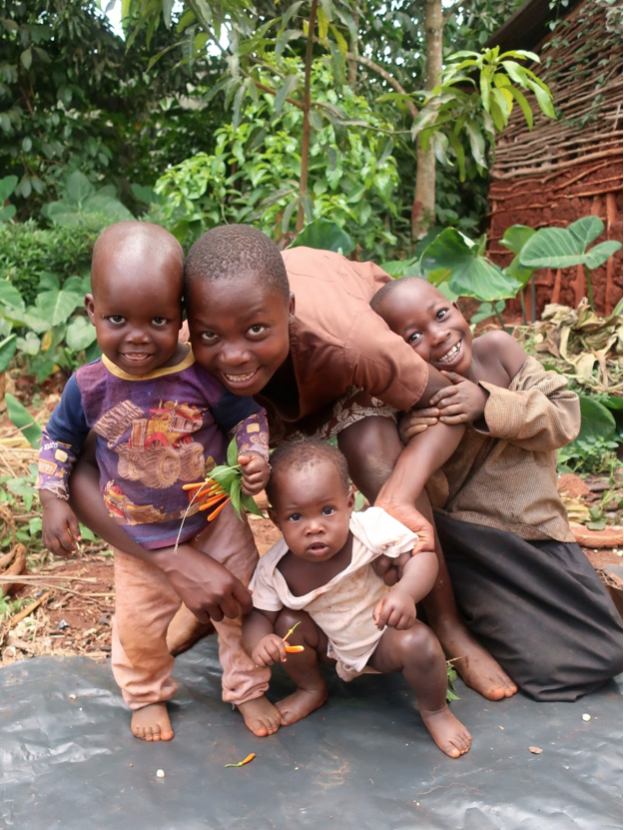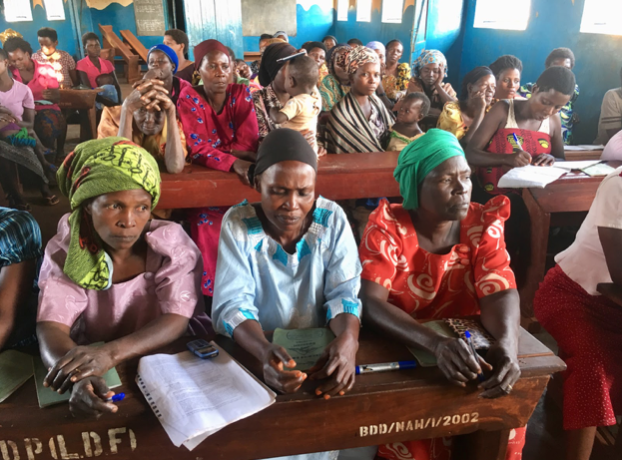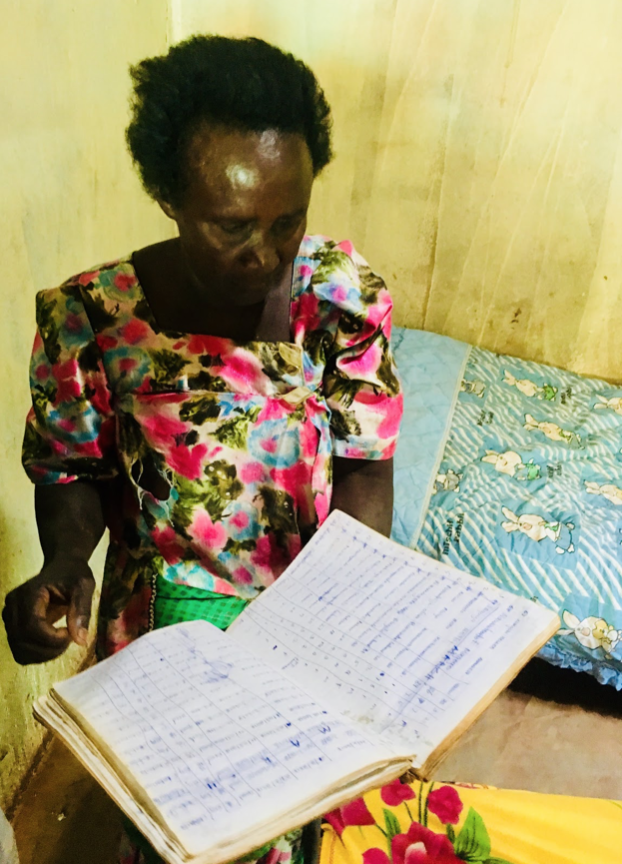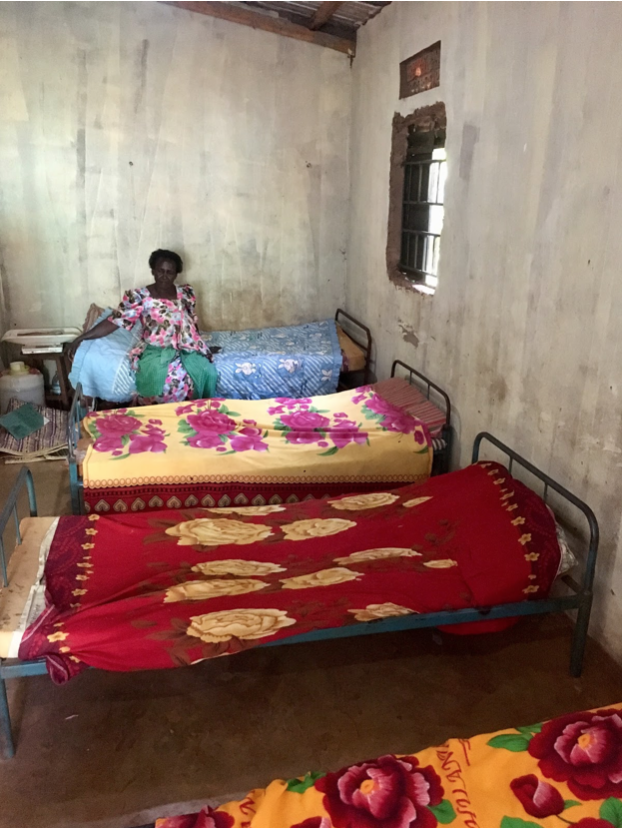GUEST BLOG BY TAYLOR WASHBURN AND EMILY CHANDLER, GLOBAL AMBASSADORS FOR ROCKFLOWER
After a joyful and engaging morning with Hope for the Future, we said goodbye to Gertrude, Tonny and their members and headed back to Mill Hill Missionaries Home to begin our second visit. We had arranged to spend the afternoon and evening with Robertson Haggai from Rainbow House of Hope at the top of Nsambya Hill.
Kampala, once called the City of Seven Hills, now sprawls over more than twenty-one hills. Traditionally the hills identified different regions of the city and Nsambya Hill has long been home to Catholic missionaries. Rainbow House of Hope (Rainbow House) is located near the top of the Hill with views of the Makindye Division slums to the south. Founded in 1998, Rainbow House introduced music and sports programs as a means of getting children from the slums off the streets. The whole operation consists of one building and a series of retrofitted shipping containers that serve as workshops for their different programs, which includes a brass band for children and young adults, skills training in hairdressing, wood and metal working, tailoring, knitting, painting, sign-making and computer literacy. This all falls under the direction of program coordinator and Rainbow House founder, Michael Mwase.
Recently, and with support from Rockflower, Robertson has begun a Slum Maternal Health and Skill Development program. Robertson and a small team of community mobilizers work to get women from the slums of Kampala to Rainbow House’s maternal health programs. Along with conveying important information to these women, the programs help to create community among a largely disenfranchised population in the city. Along with their outreach programs, Rainbow House has installed a clinic that operates periodically (once every month or so), during which women, girls and children can be seen by volunteer medical personnel. The two doctors and one nurse who support the clinic take days off from their local, private hospital positions and donate their time to make the Rainbow House clinic possible. They offer maternal health classes and workshops, as well as examinations and evaluations. While the clinic is extremely limited in terms of equipment, medications and facilities, it was very impressive to see these doctors and nurse, younger than we are, working passionately with this population and determined to do their best to support this community and program.
The clinic operates out of a second Rainbow House building located a few minutes walk from the top of the hill. When not hosting the monthly clinics, it is home to a preschool and can also provide accommodations to Rainbow House volunteers. Our visit coincided with a clinic day, so after a quick introduction to the program, we walked with Robertson down the hill to the clinic to meet the volunteer doctors and clinic attendees. The clinic was packed and patients of all ages, who had to wait hours to be seen. While patients waited, Rainbow House volunteers served a simple lunch (beans and posho or rice) that was probably more food than many of the people typically ate in a day.
We particularly enjoyed the chance to get to know and speak with Dr. Fredrick, who together with Robertson, has worked to develop the maternal health program. Having come from very little himself, he is grateful to many people who helped him become a doctor and the successful person he is today. Because of his experience, he believes fundamentally in the need to give back and help those in his country who experience extreme poverty.
Following lunch, the clinic attendees gathered and Robertson introduced us and explained how Rockflower support has enabled this program to become a reality. It was eye-opening for us to see the wide range of women there: some were there with several small children in tow, some very sick, others very pregnant. All of them were grateful for the opportunity to be seen by doctors. For many, there is no alternative to this clinic. Going to a private hospital is prohibitively expensive, and the public hospitals often do not have space or sufficient staff to attend to those in need. The work of this clinic fills a critical need in the community.
Following our visit to the clinic, Robertson and Teddy took us on a walking tour of the neighboring slums. The alleyways we walked along were filthy; filled with sewage and waste. We followed Teddy and Robertson down narrow passageways between decrepit buildings, sometimes jumping from rock to rock to avoid the puddles. This experience was easily the most challenging part of our time in Uganda. We did our best to lean into the discomfort we felt, as we sought to understand the reality of life in the slums while simultaneously acknowledging to ourselves the stark contrast to the privilege we experience and to which we are accustomed.
Along our walk, we visited three different women connected to Rainbow House. Each of them opened up to us and gave us a glimpse into their lives and the circumstances under which they live. Two of the women we visited at their homes - very small, one-room flats. In both cases, and consistent with the generous spirit of Uganda, they welcomed us into their tiny homes. One woman bought a pineapple being sold by a man in the alley and insisted we eat it with her. We were not her guests until she gave us something to eat, she said. The strength of the human spirit is amazing, as this woman with so little insisted on sharing what little she had with us.
The third woman we visited was a widow and mother of three. In her late 20s or early 30s, we visited her on an alley corner where she operates a small shop (a few racks of vegetables and a few other staples). This shop is her sole source of income and it is illegal; she does not have the required permit to operate. As such, if the authorities come they will confiscate the produce and other products she sells. That happened to her last year, forcing her to find a new corner, which she must rent from the owner of the corner building, and start over again. She cannot afford school fees for her children, but she uses what she makes to feed them. She also can not afford to leave her shop to attend Rainbow House programs, though she says she would if she could.
Despite the determination and spirit of Ugandans, the circumstances of life here are devastating. There is a critical need for community-based organizations like Rainbow House, which provide so many programs to empower Ugandans with skills so that they might lift themselves from extreme poverty. Even so, it is not possible for Rainbow House to reach and support all those in need in the Makindye Division slums. Rainbow House programs are often at capacity and, even if they were not, many women like this widow would still not be able to take advantage of them. As we left the slums to walk back up the hill to Rainbow House, we felt keenly the uphill battle Michael, Robertson, Dr. Fredrick, Teddy and others here face in bettering this community. Despite working tirelessly, there is still infinitely more work to be done. In our conversation with Michael, Rainbow House founder, he shared a bit about his life growing up in the 1970s while Idi Amin was in power, a particularly dark period in Uganda’s history. Being around kids, and knowing what it is like to have nothing motivates him to continue improving the lives of others in his community.
Having spent the day in the city, we were also able to reflect upon the differences between poverty in the cities and in the villages we have visited. In villages, families survive on what they can grow and often live in a small mud house. That can come to look fairly comfortable in contrast to the small one-room homes with sewage-filled alleys that flood during the rainy season. In the slums, there is nothing remotely close to clean water and nowhere to grow a single plant. People often leave the villages hoping for better lives in the city, but it seems the reality of village life, with the community and perhaps larger family support found there, would be preferable to the slums of the cities.
The need for the Slum Maternal Health and Skill Development program Rainbow House is developing is great, and like so many organizations they face funding challenges as well as societal and cultural barriers to accessing the communities and women in need. Yet it is the unrelenting optimism and faith in these communities and people that Robertson, Dr. Fredrick and others bring to their work that makes these programs possible. Their dedication, resourcefulness and persistence allow them to defy the odds and make programs like these a reality.




























































